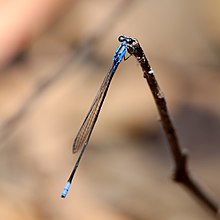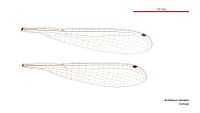
Aciagrion fragile is a species of damselfly in the family Coenagrionidae, commonly known as a blue slim. It is a small, slender damselfly, the male is blue and black. It has been recorded from northern Australia, New Guinea and the Lesser Sunda Islands in Indonesia, where it inhabits still waters and swamps.
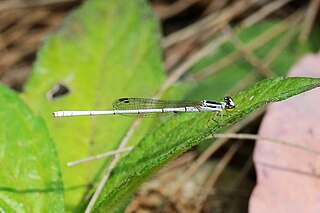
Agriocnemis argentea is a species of damselfly in the family Coenagrionidae, commonly known as a silver wisp. It is a small damselfly; the male, when mature, is covered in a white pruinescence. It is endemic to northern Australia where it inhabits both still and flowing waters.

Agriocnemis rubricauda is a species of Australian damselfly in the family Coenagrionidae, commonly known as a red-rumped wisp. It is a small damselfly; the male has a red end to his tail. It has been recorded from northern Australia where it inhabits boggy seepages and swamps.

Coenagrion lyelli is a species of damselfly in the family Coenagrionidae, commonly known as a swamp bluet. It is a medium-sized damselfly, the male is bright blue with black markings. It is found in south-eastern Australia, where it inhabits streams, pools and lakes.

Pseudagrion ignifer is a species of damselfly in the family Coenagrionidae, commonly known as a flame-headed riverdamsel. It is a medium-sized damselfly with an orange face and pruinose sides to its body and the start of its tail. It is found in eastern Australia, where it inhabits streams.

Neosticta canescens is a species of damselfly in the family Isostictidae, commonly known as a southern pinfly. It can be found in eastern Australia, where it inhabits streams.

Austrolestes aridus is an Australian species of damselfly in the family Lestidae, commonly known as an inland ringtail. It is widespread across inland Australia, where it inhabits streams, pools, and ponds.
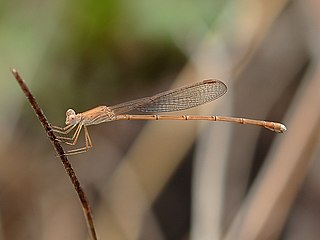
Austrolestes insularis is an Australian species of damselfly in the family Lestidae, commonly known as a northern ringtail. It is widespread across northern Australia, where it inhabits streams, pools, and ponds.

Indolestes alleni is a species of damselfly in the family Lestidae, commonly known as a small reedling. It is found across northern Australia where it inhabits lagoons, ponds and swamps.
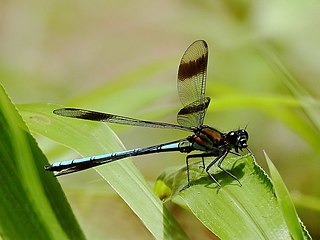
Diphlebia hybridoides is a species of Australian damselfly in the family Lestoideidae, commonly known as a giant rockmaster. It is endemic to north-eastern Queensland, where it inhabits streams in forests.

Diphlebia nymphoides is a species of Australian damselfly in the family Lestoideidae, commonly known as an arrowhead rockmaster. It is endemic to eastern Australia, where it inhabits streams and rivers.

Lestoidea conjuncta is a species of Australian damselfly in the family Lestoideidae, known as a common bluestreak. It is endemic to coastal north-east Queensland, where it inhabits streams in rainforest.

Austroargiolestes alpinus is a species of Australian damselfly in the family Megapodagrionidae, commonly known as a New England flatwing. It is endemic to north-eastern New South Wales, where it inhabits streams and bogs.

Austroargiolestes chrysoides is a species of Australian damselfly in the family Megapodagrionidae, commonly known as a golden flatwing. It is endemic to south-eastern Queensland, where it inhabits streams in rainforest.

Austroargiolestes aureus is a species of Australian damselfly in the family Megapodagrionidae, commonly known as a tropical flatwing. It is endemic to north-eastern Queensland, where it inhabits streams in rainforest.
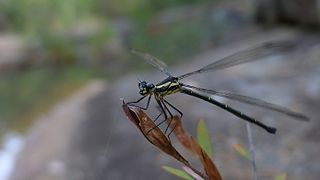
Griseargiolestes eboracus is a species of Australian damselfly in the family Megapodagrionidae, commonly known as a grey-chested flatwing. It is endemic to eastern Australia, where it inhabits bogs.

Griseargiolestes fontanus is a species of Australian damselfly in the family Megapodagrionidae, commonly known as a springs flatwing. It is endemic to south-eastern Queensland and north-eastern New South Wales, where it inhabits streams near their springs.

Griseargiolestes intermedius is a species of Australian damselfly in the family Megapodagrionidae, commonly known as an alpine flatwing. It is endemic to alpine areas of Victoria and New South Wales, where it inhabits bogs and seepages.

Episynlestes albicauda is a species of Australian damselfly in the family Synlestidae, commonly known as a southern whitetip. It is endemic to south-eastern Queensland and north-eastern New South Wales, where it inhabits streams and pools in rainforests.

Synlestes selysi is a species of Australian damselfly in the family Synlestidae, commonly known as a forest needle. It is endemic to eastern New South Wales and eastern Queensland, where it inhabits streams.
